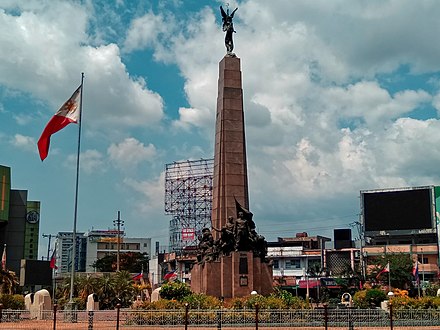Caloocan - city of the Philippines in Metro Manila
Caloocan or Kalookan is a city in northern Metro Manila.
Understand
Once a large municipality of Rizal, Caloocan today is divided into two non-contiguous areas, urbanized South Caloocan and suburban North Caloocan (also known locally as Bukid as it used to be countryside of rice paddies), a result of the absorption of its several barangays (then barrios), most notably Novaliches, into Quezon City, established to be the capital of the Philippines. Caloocan today forms one large suburb of Manila, and is predominantly residential, mostly home to people relocated from Manila's slums. There is also a noticeable lack of tourist attractions.
Get in
By plane
The city, like the rest of Metro Manila, is served internationally by NAIA.
By train
Take the LRT Line 1 and alight at either 5th Avenue or Monumento stations. You can also take the MRT and transfer to a bus at North Avenue and continue onward to Monumento, or take the LRT from Roosevelt or Balintawak stations up to Monumento.
Philippine National Railways (PNR) operates commuter trains between Tutuban or FTI stations (in Manila and Taguig respectively) and Governor Pascual station in Malabon. Trains call at 5th Avenue, 10th Avenue (Asistio) and Caloocan (Sangandaan).
By bus
Caloocan is the terminus of the EDSA Carousel bus rapid transit line from Parañaque via EDSA. Other city bus routes also pass through Caloocan, originating from Bulacan or Parañaque via MacArthur Hwy, Rizal Ave and C-4 Road.
Victory Liner, which is headquartered in the city, has provincial services to its terminal near Monumento, and is the only provincial bus company serving the city. Other companies now only serve Cubao or Bocaue.
By jeepney
Jeepneys connect Caloocan with Manila, Malabon, Quezon City and Valenzuela. Many of these take Rizal Ave to Monumento or M.H. del Pilar St across the old town. They are also the predominant way to reach North Caloocan.
By car
Caloocan is served by EDSA and MacArthur Highway (Hwy 1), and C-4 Road (Rte 120). From Manila, it is connected via Rizal Avenue (Rte 150). The nearest expressways are North Luzon Expressway (NLEx) and the elevated Skyway. It takes about 40 minutes by driving to reach Caloocan.
North Caloocan is served by road via Novaliches in Quezon City or Valenzuela.
Get around
If you need to use public transportation try sakay.ph, it will show you the right type to your destination.
Small but convenient and very affordable tricycles ply around the city. Just say where you are going and they will bring you as fast as possible. Fares are at the range of (for single person payment) to (if you want to ride the tricycle on a "special" basis - meaning you and your companions are the ones that will ride.)
Jeepneys also ply around with their own respective fixed routes. Metro Manila fares of a minimum of is applied. The city is geographically divided in to 2 parts, Caloocan City North and South. Taking a tricycle from Bagong Barrio, for example, is a big no-no among drivers. And besides, it is also not allowed by the local government.
See

- Bonifacio Monument (Monumento), Caloocan City. This famous landmark of the city is located at the intersection of EDSA, Rizal Avenue, Mc Arthur Highway, and Samson Road. Made by National Artist Guillermo Tolentino, the monument commemorates the first encounter of the revolutionary group Katipunan, lead by hero Andres Bonifacio, with Spanish forces. 2020-10-09
- San Roque Cathedral (Caloocan Church), Caloocan City. A Catholic church in the Poblacion district. 2020-10-09
- Gubat sa Ciudad Resort - features several swimming pools and other water facilities for the whole family.
Do
Buy
Eat
Budget
All these are around the Andres Bonifacio National Monument:
- Perry's Chicken House, 159 12th Ave, Corner 8th St, East Grace Park, 14.6542075°, 120.9904813°. 2022-08-01
- Tapa ni Mama, 138-B Asuncion, Morning Breeze, 14.6593111°, 120.9876526°. 2022-08-01
- Tony's Eatery/Restaurant, 8th Ave, East Grace Park, 14.6488064°, 120.9838952°. 2022-07-01
- Tapsilogan Ni Mama Leng, 267 D. Aquino St. Between 9Th And 10Th Ave., Grace Park West, 14.6514059°, 120.9795131°. 2022-08-01
Mid-range
- Padi's Point Restaurant and Bar, Grandz Commercial Building, McArthur Highway, Calle Cuatro, 14.6600594°, 120.9842318°, +63 2 359-0413, +63 2 809-7308, padislaspinas@yahoo.com. 6PM-3AM. Serves Filipino, grill, seafood, Spanish dishes.
Splurge
- The Alley by Vikings, 2nd level, Ayala Cloverleaf, A. Bonifacio, 14.6557311°, 121.0007690°. 2022-08-01
Drink
Sleep
- Kabayan Hotel Monumento, 535 Caimito Rd. corner McArthur Highway Monumento, +63 2 7022700. It offers 76 guestrooms, consisting of Premium, Superior, Family, Pad and Dormitory-type accommodations. Rooms are furnished with essential amenities such as air-conditioning, cable TV, and Internet connectivity. Some of its facilities and services include function/meeting rooms, business center with Internet facility, coffee shop, prayer room, safety deposit boxes, laundry and room service, and on-call massage service. From
Connect
- Internet cafes. 24 hours. All over the city. from 2020-10-08
Stay safe
Northern Caloocan has a bad reputation for giant slums; exercise caution and stay away from any obvious slum area if you travel alone. Illegal drugs and petty crime is a major concern, so better stay away from those areas.
Women travelers must avoid walking alone, especially near run-down areas. Rape cases are all too common in the city, though most cases involve local females. After a controversial ordinance was signed, wearing skimpy shorts in public locations, including city streets, can lead to a fine.
Go next
Caloocan
caloocancity.gov.phNorthern Manila District
2nd-order administrative division
Metro Manila
Primary administrative division